

THE TEMPLE IN RADIERS
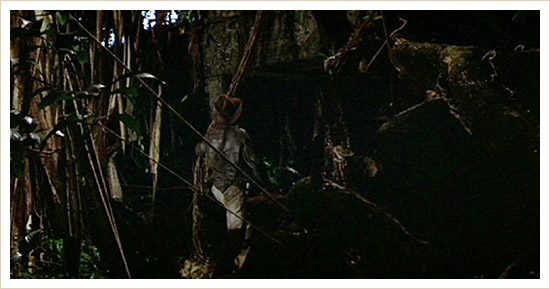
Indy’s dangerous Andean jungle trek brings him to the mouth of a temple cloaked in overgrowth. In the film we see almost nothing of this temple but its mouth, and even that is barely discernible. The coming action takes place inside this ancient structure, which can only be reached by a long, narrow entrance corridor leading uphill. The Raiders script and novel tell us that this is the Temple of the Chachapoyan Warriors.
THE REAL TEMPLE: KUELAP OF THE CHACHAPOYANS
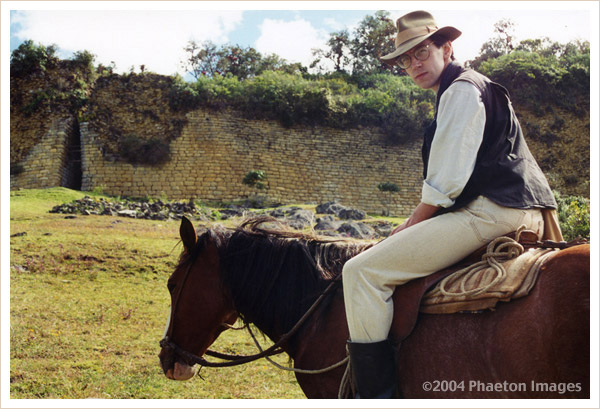
More extraordinary than all the perils waiting in the cinematic Temple of the Chachapoyan Warriors is the fact that this fearsome movie monument echoes a real ruin. Though little known, the massive site called Kuelap is one of the greatest ancient monuments in the New World. In contrast to the world-wide fame of Machu Picchu, few people are familiar with Kuelap because it lies hidden in the heart of remote Chachapoyan territory. It is Kuelap that the real Indiana Jones must have sought and reached.
Lucasfilm producer extraordinaire Rick McCallum sent me location scouting to Peru in 1996. As part of this expedition I decided to travel all the way into the northern Andean reaches that had been represented in the opening sequence of Raiders of the Lost Ark. The roads got progressively worse and the towns and villages got smaller and farther apart until the territory seemed almost completely uninhabited.

At one point I crossed the Utcubamba river via a cable-suspended platform on which you had to haul yourself across hand-over-hand. On the other side of the river–which would have been the same river where Indy contemplated the waterfalls–I stood at the base of a mountain crowned by the real-life destination of the fictional Indiana Jones. From here I proceeded uphill on horseback, making my way up the steep slopes on a thin and crumbling trail for two hours until the great ruin became visible above.
Kuelap forms a massive oval 2000 feet long. It covers the entire top of the mountain summit. Not just a temple but an entire fortress city, Kuelap stands at an altitude of almost 10,000 feet. Sheer defensive walls reaching 20-25 feet high surround the city, and above this level rise two more levels of walls within. Ruins lie on the upper terraces, shrouded in jungle bromeliads and orchids. This forbidding enigma was the greatest work ever built by the Chachapoyas peoples, and one of the largest constructions in the world: an estimated 100,000 stone blocks compose the outer two defensive walls, which weigh an estimated 10,000 tons.


All this effort was expended for one purpose: defense against any intruder. So you can search around the walls for thousands of feet in vain for any entrance. You will be forced to take one of only three entrances built by the Chachapoyans, and as soon as you neared one centuries ago, you would have realized that they were ready for you. A dark slit opens in the main face of Kuelap, daring outsiders to defy its protections.
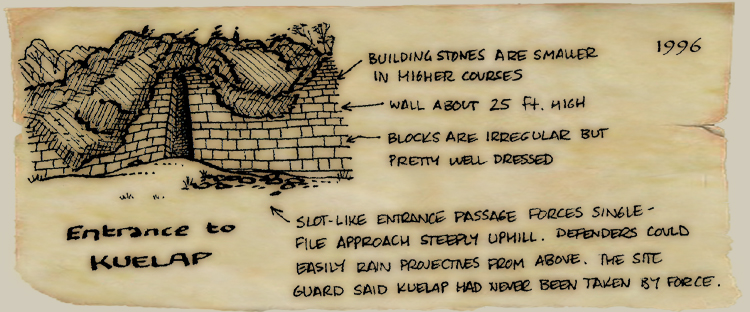
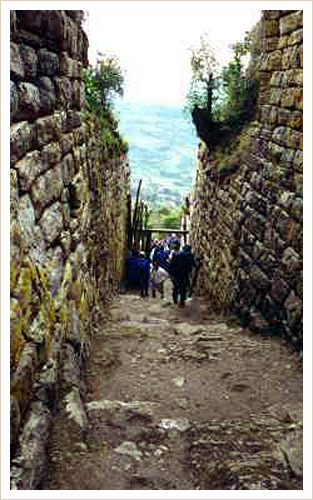
In Raiders of the Lost Ark, Indiana Jones must walk through a narrow, constricted passage that slopes upward as he tries to penetrate the depths of the Temple. The real Kuelap forces you to take exactly the same kind of route. As you climb the 100-foot-long passage you realize that the ancient defenders built the inward-sloping walls like a bottleneck, to force any intruders to walk single-file, exposed to attack from fighters hidden in the turrets and ramparts above. This was an effective defense that frustrated the Incas during their difficult campaign against the Chachapoyan warriors.
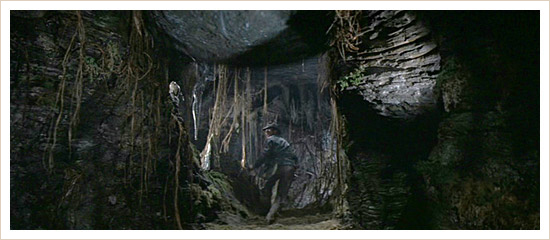
Making my way up this route, I could not escape the recollection of the rolling boulder from the film. Were such a boulder rolled down this passage, anyone inside would be unlikely to escape alive. Did the real Chachapoyans ever send such a deadly object rolling down on intruders? As of yet we have no evidence either way. We can only consider that the Chachapoyans were accomplished stoneworkers and that they built Kuelap with defensive tactics in mind above all. A defensive boulder would certainly have been within their technological capability.
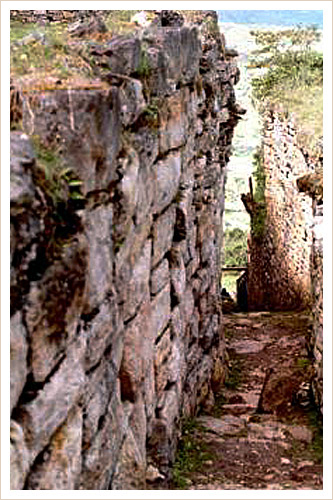
Beyond the top of the entrance channel, the Chachapoyans were not finished with their defenses. Invaders who survived the ramp would find themselves at the base of a second ramp, which seems to lead to the upper inhabited level. Careless intruders rushing upward in enthusiasm–”there is nothing to fear here!”–would suddenly find the ground disappearing beneath their feet. The ramp actually led to a chasm trap, again much as we see as Indiana Jones faces a pit in Raiders.
Beyond the top of the entrance channel, the Chachapoyans were not finished with their defenses. Invaders who survived the ramp would find themselves at the base of a second ramp, which seems to lead to the upper inhabited level. Careless intruders rushing upward in enthusiasm–”there is nothing to fear here!”–would suddenly find the ground disappearing beneath their feet. The ramp actually led to a chasm trap, again much as we see as Indiana Jones faces a pit in Raiders.
These correspondences are probably nothing more than coincidences, or perhaps the result of indirect influences, but they make Raiders of the Lost Ark resemble reality in striking, surprising ways.
Behind the defenses of Kuelap lies a mass of ruins on various terraced levels, largely unexplored. Where the archaeologist A. Ruiz Estrada had cleared away some of the jungle during his work in 1967, I saw the rings of Chachapoyan house foundations, the bands of geometric decoration that distinguished this stonework from Inca work, and many walls half-tumbled beneath thick jungle growth. Cryptic shapes lying half-exposed invite curiosity: what strange building required a star-shaped plan or the shape of an inkwell? Was a turret-like construction some kind of observatory? This mighty mass of construction once housed perhaps 2,000 people, judging by its size. The edges of the wall offer lookout vantages over all the wild Andean territory surrounding the site, and leading down from the wall’s base in every direction stretch the steep slopes where the ancient peoples once farmed. Those, I reflected, are the same slopes down which a real Indiana Jones would have fled for his life, toward the river far below.
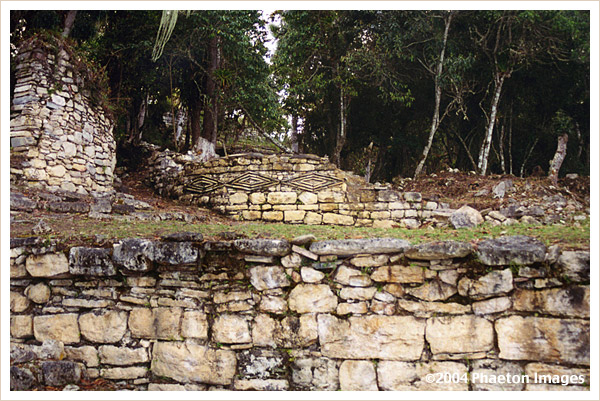
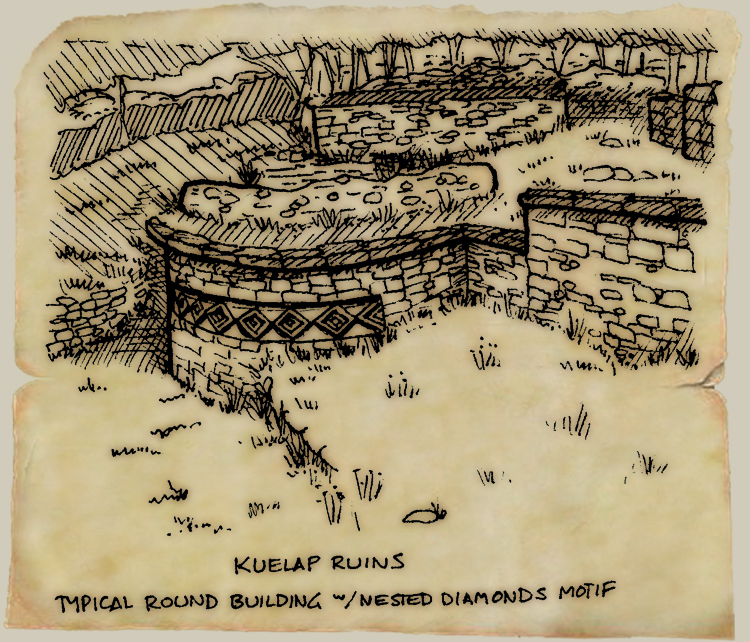
Kuelap was discovered in 1843 by Juan Crisostomo Nieto. A few adventurers therefore, preceded our fictional archaeologist of 1936. But then, Raiders gives evidence of at least two who had arrived before Jones–the mysterious maker of his map (Nieto himself?)–and of course the unfortunate Forrestal. Since Kuelap’s discovery, only Ruiz had done much to explore it before further efforts resumed very recently.
Somewhere within this great ruin, perhaps entirely covered by jungle, lies whatever remains of the ancient religious structures of the Chachapoyans. Somewhere here must lie a real Temple of the Chachapoyan Warriors. While Indiana Jones had a map that allowed him to find and penetrate its depths, the real temple, if there is one, will have to wait for further archaeological work before its secrets are revealed. Until then, the enigma of Kuelap gives us plenty to contemplate. And on the movie screen, the adventure of Raiders of the Lost Ark dramatizes the forbidding atmosphere of mystery that still envelops the site today.
What about everything inside the Temple of the Chachapoyan Warriors–the tarantulas, the booby traps, the golden idol? How much of it is realistic, and what inspired it all?
We’ll venture inside with Indy and find out… next month!

< PREVIOUS
